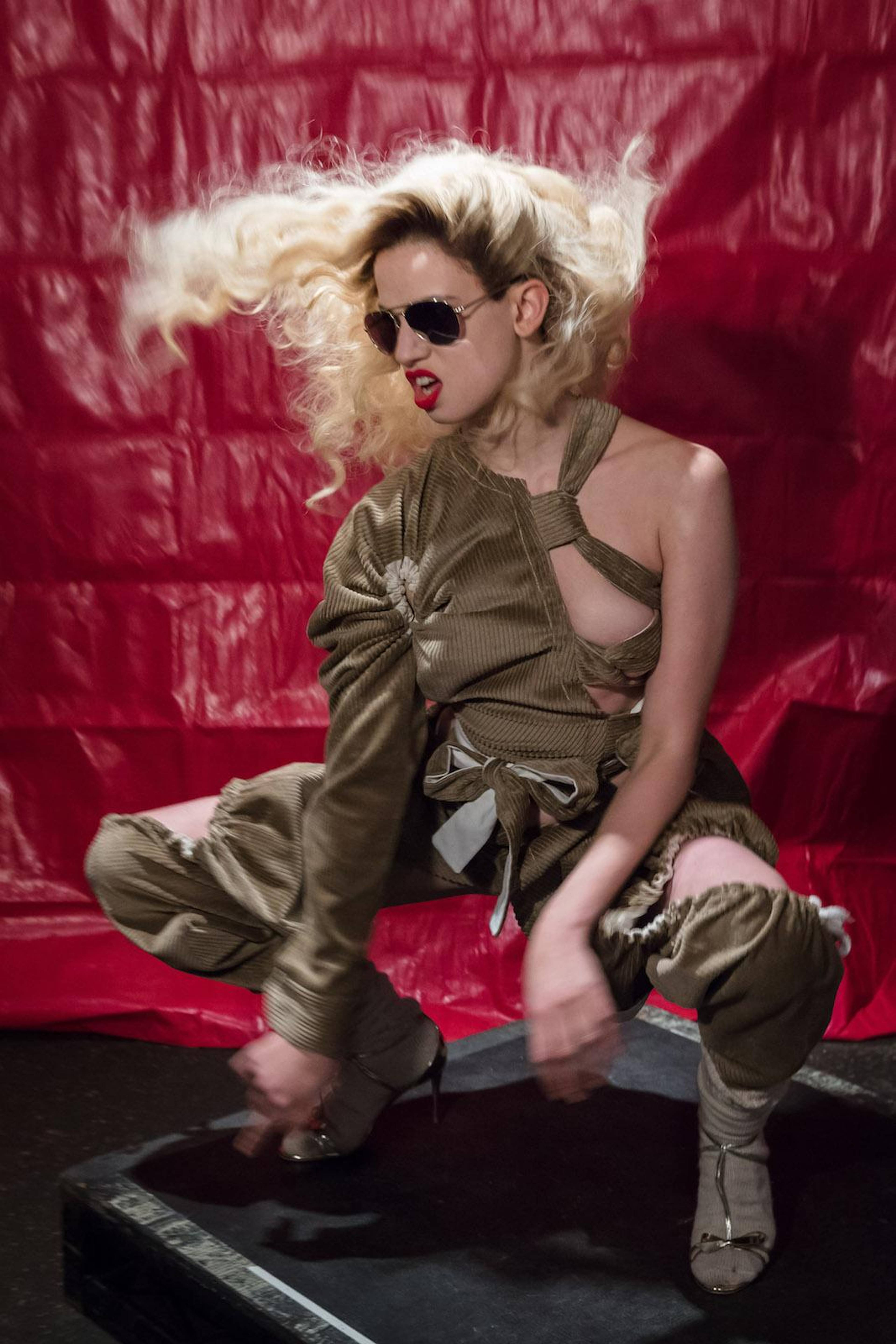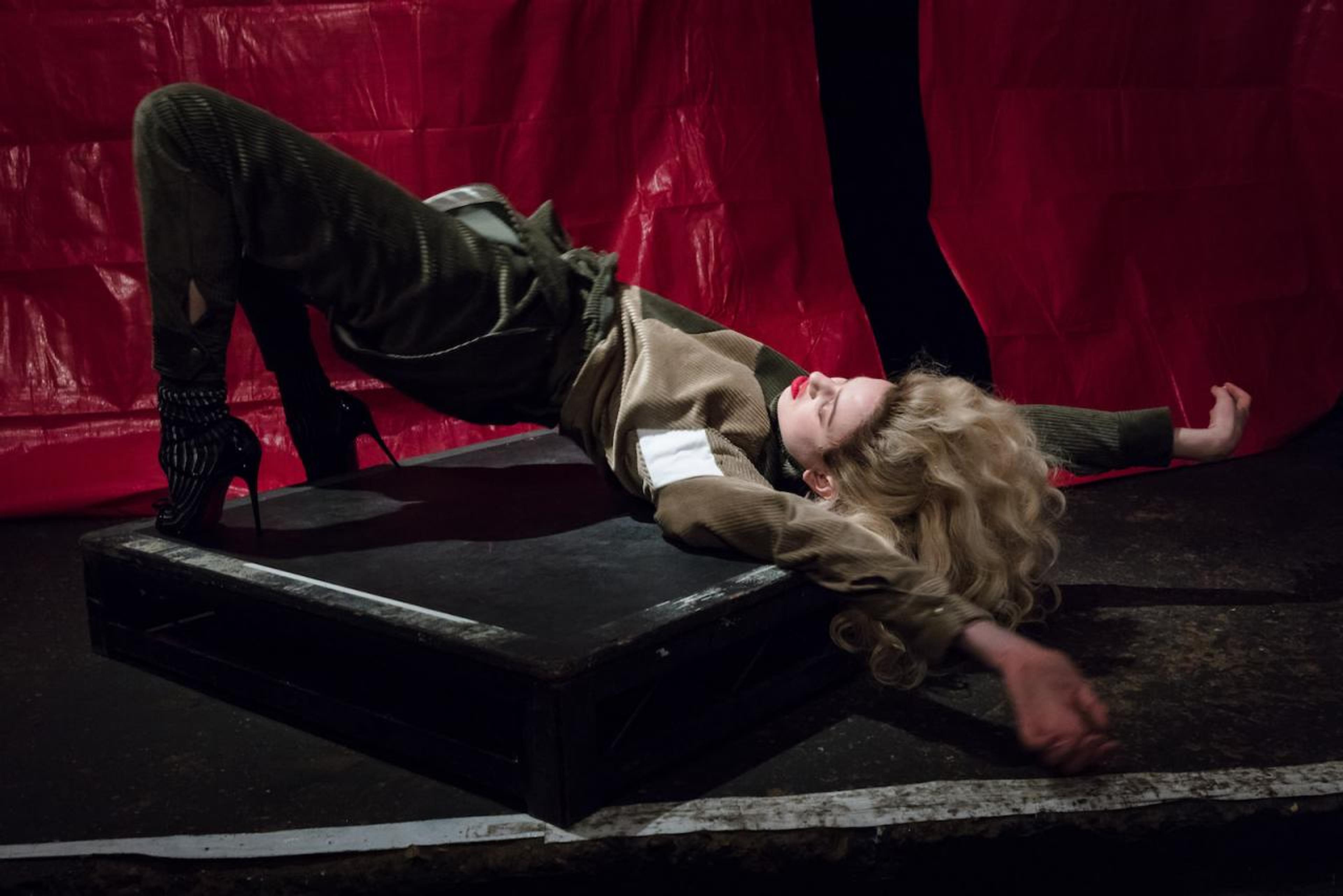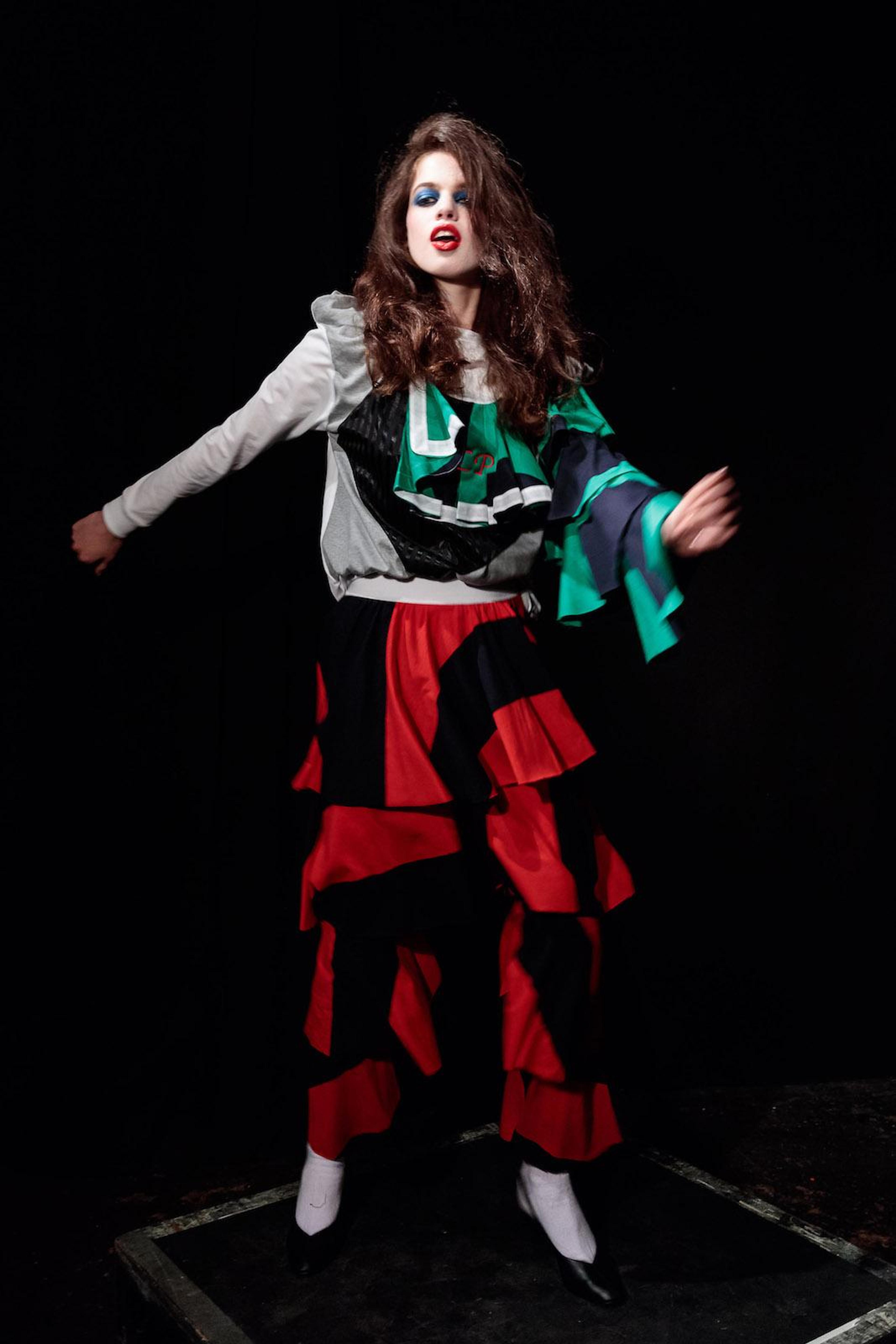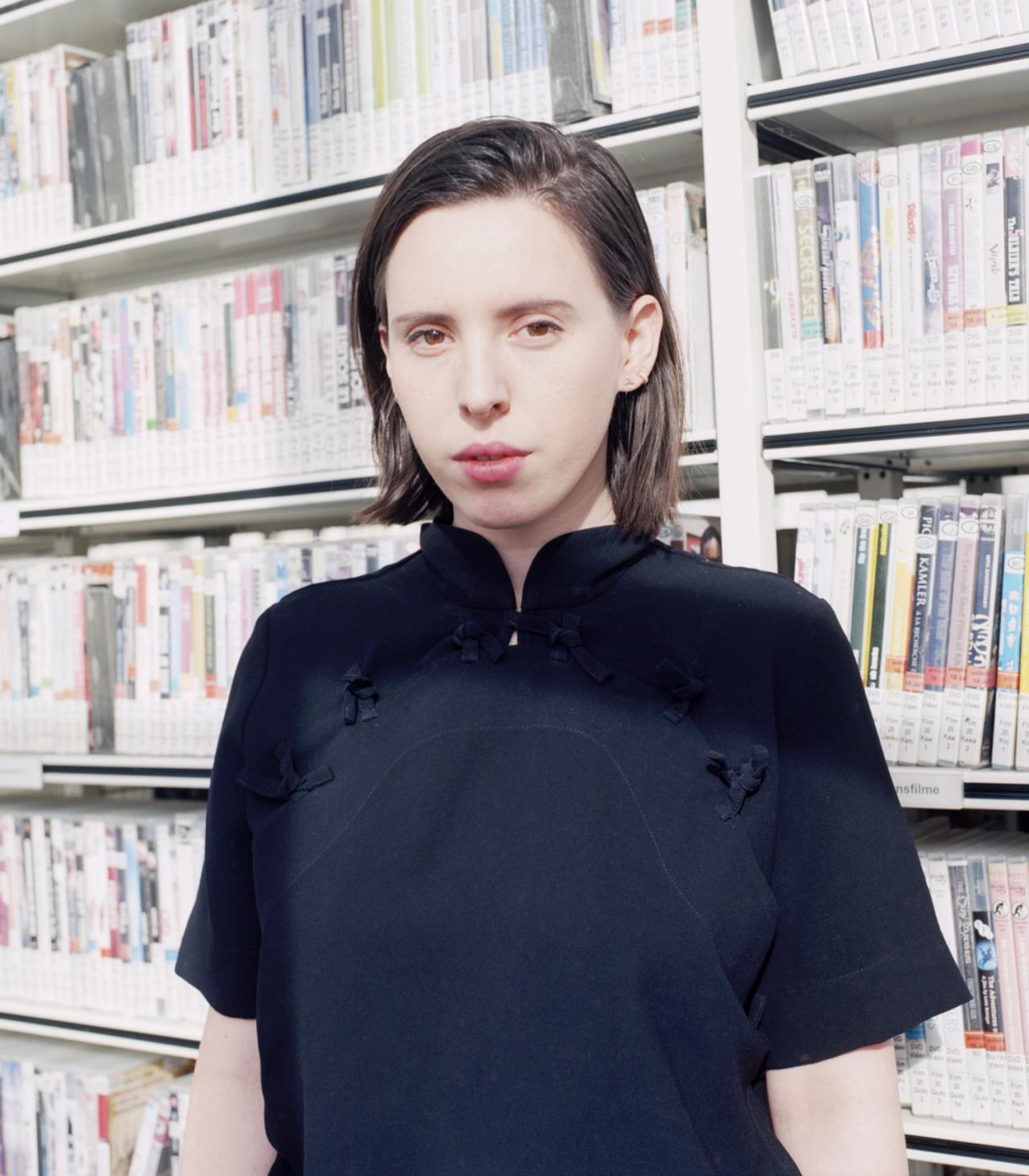Alexander Scrimgeour : What makes fashion such an important subject today?
Alessandro Bava : Generally, fashion is seen as pejorative in the straight and male-dominated art world. If it is considered not as a market, but as the practice of expressing identity and zeitgeist via how one decides to cover oneself, fashion is possibly one of the most contemporary mediums for creative work. It challenges the narcissistic idea that art is meant to last forever, while fashion is ever-changing and therefore less important. I’d argue that we’re on the brink of the singularity, so forever doesn’t matter.
Emily Segal : In terms of “knowing the now”, fashion is basically the only metaphor we have: it is totally interchangeable with what we consider to be “the now”.
Alexander Scrimgeour : Because it moves more quickly than art, or it’s more responsive to something?
Emily Segal : It isn’t only about responsiveness. Art now changes really quickly because people are making images all the time and the global codes and trades are moving really fast. Fashion, meanwhile, is only about that emergent behaviour and every single person changes fashion every single day when they get dressed. It’s important that it’s also under the radar and not scrutinised from head to toe in the same way that art is, because it means that it can move and emerge in more interesting ways. There’s this cliché about the mixture of art and fashion, which assumes that it is a way to make fashion seem more high-brow and serious, on the one hand, and to make art seem more appealing and easy to consume, on the other. But that’s given rise to this situation now where there have been so many actual institutional convergences. The Fondation Louis Vuitton, the Fondazione Prada, and the Loewe Foundation all represent this new genre of museums that are brand centres for fashion brands.
Symonds Pearmain Haute Militaire, AW 2017 The Horse Hospital, London
Alessandro Bava : It comes from a really basic effort by brands to position themselves on what is perceived to be “higher ground”: that of the fine arts. But fashion designers have also become pseudo-curators – as creative directors, they almost naturally extend into other realms of creativity. There are many designers like, say, JW Anderson, who completely absorb art into their collections and collaborate with artists or even feature them in exhibitions. The creative director has become a totemic figure who curates a brand on every level. That includes clothes, but also images and advertising – the full extent of image-making.
Curators are playing a bigger role in fashion as well. In 2015 there was a Brioni advertising campaign for which the Paris-based curator Nicolas Trembley had John Armleder, Karl Holmqvist, Tobias Madison, and Seth Price participate in a shoot by Collier Schorr. This crossover shows how far we are from what it was like in the early twentieth century, when art and fashion started to merge, when artists would work with a designer in collaboration. I consider the more recent merging of art and fashion a bad deal for both sides, since it dilutes meaning and authenticity for both of them. I did like the new approach Prada recently attempted, asking some architects and industrial designers to design items of clothing that were actually shown on the runway. While this was still a marketing gimmick, it seemed to have at its root a genuine concern for design innovation.
"The contemporary is this emergent stew. It’s moving all the time, and you do have to have an awareness of it if you’re trying to mix into it." (Segal)
Emily Segal : The creative director represents a new position in culture, and not just in fashion. K-HOLE once did a mini report in 032c reacting to a major fashion head-hunter’s assertion that the role of the creative director was taking over the role of the CEO. That was meant as a provocation and i’m sure it helped her head-hunting business, but it was also reacting to how a lot of tech brands were poaching people from the fashion industry; there was a big exit from Burberry to Apple, for example, that excited people on both sides of the aisle. The idea was that a generalised creativity could create positive business outcomes in any context and that a single person with their individual aura of coolness could manage a type of uncertainty that your traditional CEO, with his pie charts and numbers, couldn’t.
Alessandro Bava : We have also seen the opposite vector: the rejection of creativity in art. I think art has been trying to become corporate but was also late to it [laughter]. The value-making machine surrounding artists is trying to follow art “trends”, attempting to emulate a corporate model of reading what’s going on and producing commodities in response to that. At the same time, there are some fashion brands, like Symonds Pearmain, which are getting closer to art, by moving their market strategy away from serial industrial production and turning to the elite economy of galleries, selling pieces of clothing as artworks, in numbered editions. For me this is totally cynical as a market strategy – but it becomes interesting if we accept that making clothes is a creative practice that has as much to do with creating and shaping identity as art does.
Look 2 – Mime Symonds Pearmain, Retail Baroque, SS 2016 The Horse Hospital, London
Emily Segal : Fashion in general is a really interesting model for oppositional logic. I grew up with a mother who is really super steadfast in the fact that you should never look like anyone else and that it is really lame and shameful if you dress the same as everyone else. That was something I wrestled with for a really long time when I was attracted to a trend or wanted to look like somebody else. It taught me a lot about what it means to be contrarian or not and I realized that if you’re only ever making decisions in order to be different you don’t have a lot of freedom about the decisions that you’re making. It taught me two things: one is that fashion is a very interesting laboratory for aesthetic decision-making and one that everyone does every day; you can learn a lot from just observing your own choices in that.
And the other is that being strictly contrarian, which a lot of our art practices and artists are, is actually not a very liberated position, because you’re always reacting. The contemporary is this emergent stew. It’s moving all the time, and you do have to have an awareness of it if you’re trying to mix into it, but also you have to do that with the understanding that you’re never going to completely wrap your arms around it.
"We look at history to place ourselves outside the contemporary, and somehow that is seen as more contemporary" (Bava)
Alessandro Bava : The idea of the contemporary is a valid preoccupation, but at the same time it’s frustrating because it’s also a very geographically-skewed notion, so much so that i would say a concern with the “now” can seem almost colonialist.
Alexander Scrimgeour : There is also a growing pressure to keep up. It’s become harder and harder to live up to what Rimbaud said: that you have to be completely modern.
Emily Segal : When K-HOLE started, we were reacting to a very nostalgic, sentimental moment in culture. In 2009 there was Cabinet magazine and there were all these ye olde drawings of these ye olde steam engines and all these pamphlets and little magazines that we loved and we bought and we were obsessed with. There was a sense that the book was dissolving, so we had to pile a million books up on the table and that was also really weighty. It all felt like it was grinding to a halt in its own nostalgia, like it was going in a circle, and I felt like the only way to get to the next moment was to reject it completely and talk about the future and the present, and make something that didn’t have a physical form.
Look 2 – Mime Symonds Pearmain, Retail Baroque, SS 2016 The Horse Hospital, London
Alexander Scrimgeour : Also by adopting commercial or corporate models?
Emily Segal : Yeah, I think that’s part of it. We saw all of our friends pretending that what they did as artists and what they did during their day jobs were somehow completely separate, but they were doing corporate things and art things together all the time to live. In New York, if you have no money, you have no health insurance; if you break your leg your life is ruined. Compared to Europe, there is a much, much bigger sense of economic precarity and far fewer institutions and grants, so all young artists who aren’t rich have to work.
Alessandro Bava : The corporate ethos also feels more contemporary because it has to reject nostalgia completely. Around 2010, I also had the sense we were living in a historical moment in which people wanted to reject nostalgia and I think now, especially in fashion, a sense of the past is coming back – but not as nostalgia. Instead, it’s being packaged as something that is outside of its time (look at Gucci, for example, or some Dior collections by Raf Simons or Nicolas Ghesquière’s Louis Vuitton collection, shown at the Louvre in 2017). I think that is a different model, in which we look at history to place ourselves outside the contemporary, and somehow that is seen as more contemporary. Incoherence and history are the two strategies designers have been adopting to fuel the endless need for newness.
"I think that while fashion doesn’t dictate how people dress, it dictates how people think about how they dress" (Bava)
Emily Segal : This type of incoherence, this picking from many different his- torical moments and mashing them all together also comes from the desire to have a look that lasts forever because it is never “now”. It is one of the impossible dreams of fashion, and it’s also reacting to the way fashion talks about itself, where it is always trying to recycle influences from not that long ago. The 70s are always coming back; every magazine is about Jean Seberg or Studio 54 – these exact same middle-distance historical characters and girls who just get put out every season as if they’re a new old reference.
Alessandro Bava : I hate when that happens, because I take fashion garments seriously. I think, as a medium, fashion is comparable to architecture and art in how it conveys a narrative in many dimensions at the same time. How these objects come to life is amazing and fascinating and complex in the same way as it is for a building or a sculpture. The problem with buildings is they last longer. In the 70s the group of architects Archizoom, for example, turned to fashion as a way of saying that they saw making clothes as integral to architecture, just like the human body itself. The idea was that if you can make something that doesn’t have to last for a long time you’re, in a sense, sharper.
Alexander Scrimgeour : So fashion moves faster than buildings, faster than art. These hopes that we’ve invested in the avant-garde in an art sense, do you see them now in fashion?
Emily Segal : Theoretically, yes, but if you look at what everyone in this room is wearing, the majority of it could have existed thirty years ago. Some of the fibres would be different and probably the sneakers would be a little bit different but the overall look, codes about what is appropriate or not, and the colours would be the same.
Symonds Pearmain Haute Militaire, AW 2017 The Horse Hospital, London
Alessandro Bava : The most fascinating thing about fashion is also the fact that it’s not necessarily what you see on people.
Emily Segal : Could you explain what you mean?
Alessandro Bava : Well, I don't necessarily look at people on the street. I don’t find that as interesting as looking at a fully-formed expression of someone’s creative process on a runway. I get most excited when I see clothes that no one has worn. It’s analogous to the relationship between what you see in a museum and what you see on people’s house walls.
Emily Segal : We’re completely opposite.
Alessandro Bava : I think of it in a more naïve way, maybe. I’m not so invested in the social meaning of fashion and how it’s distilled in people’s choices in their everyday lives; I’m more interested in a garment as a garment and the creative output. I think that while fashion doesn’t dictate how people dress, it dictates how people think about how they dress.
Emily Segal : Still, it’s really interesting that the fantasy world of fashion – or fashion as this machine that produces these creative and beautiful and fanciful and utilitarian objects – exists on the same spectrum as where people get dressed every day. I grew up learning about fashion in two ways, besides my mom and her rules, one of which was watching the runways without commentary on New York public access cable TV. I would just gawk at it. And then I would be sitting on the subway with my face at someone’s hip level, seeing what they were wearing. To me, these two visual points from which I took in fashion information are part of the same system, but they have very different implications.
"I find a lot of contemporary art completely illegible and i’m not just saying that to be cool" (Segal)
Alexander Scrimgeour : What would art have to give up if it were to become closer to fashion?
Emily Segal : For me, the difference between fashion and art is that art thinks of itself as art – that sounds like a way of getting out of answering the question [laughter], but what I mean is that art gives itself permission and a mandate to experiment and express things, or to dissent from a prevailing culture – and also to make creative decisions for no reason other than the desire to make those decisions, whereas fashion, even at its most experimental, is still tied to some more fundamental things, like the body, in some sense, or the fashion system, which is much more specific than the art system. Art can take a lot more forms than fashion.
Alessandro Bava : But there is also the dark side of the connection between art and fashion. In a way, art is much more elitist and speaks to the elite much more than fashion does. Fashion is more populist even when it’s inaccessible, because, as a narrative device for talking about the now, fashion is much more democratic. Since the dawn of time, art speaks to the ruling powers, to put it in a very old-school way. Fashion is much more open, because it’s more understandable.
Emily Segal : Fashion is more invested in legibility, while contemporary art as we know it today is more invested in illegibility. I find a lot of contemporary art completely illegible and i’m not just saying that to be cool. I’m really close to it and have a lot of information, context and education about it and I still find it illegible. That’s a choice in a lot of ways, it’s a strategy that a lot of people are employing.
Alexander Scrimgeour : Perhaps to make a space for diffculty to exist?
Emily Segal : Sure. I think, at its best, art really achieves that: it creates a space where you come face-to-face with what it means for things to be illegible. But there’s the sea of things that are illegible for the sake of it, and you never have that moment of reckoning.
Alessandro Bava : I think both fashion and art have this fundamental, almost political role in which they contribute to the transformation of the collective sensibility that guides our relationships with one another and with our aesthetic world. That sounds crazy but I think it’s super important and beautiful: fashion and art both have the political role of moving things collectively, for everyone.
This text appears in Spike Art Quarterly #55 and is an updated version of a conversation that took place at Paris Internationale in 2015. We are grateful to both participants for their willingness to revisit the text and clear it for publication.
ALEXANDER SCRIMGEOUR is an editor at Spike Art Quarterly based in Berlin.
Photo: Calla Henkel & Max Pitegoff
EMILY SEGAL is co-founder of Nemesis Global, a think tank based in Berlin, Helsinki and New York City. She also co-founded K-hoLe (2011–2016).
Photo: Stefan Schwartzman
ALESSANDRO BAVA is an artist and architect based in London and Naples. He is the founder of the art collective åyr, and the independent ecology magazine and publishing platform ECOCORE.








